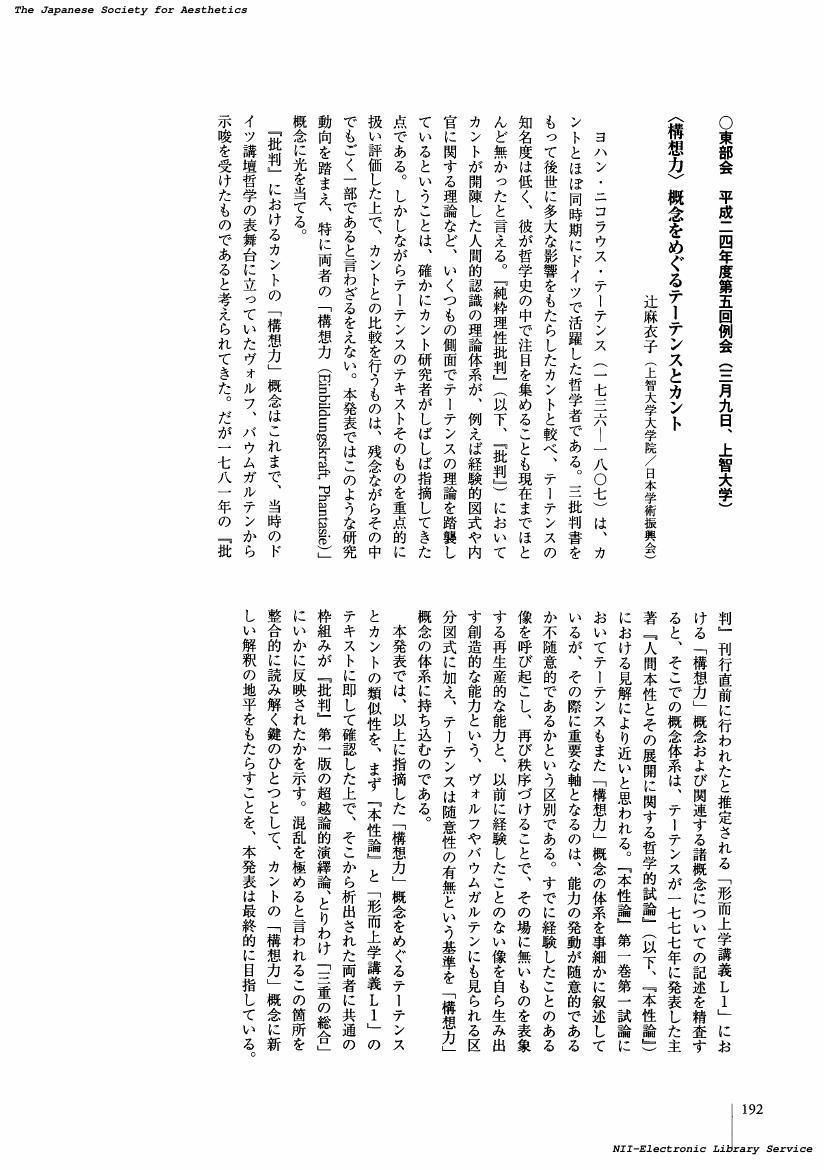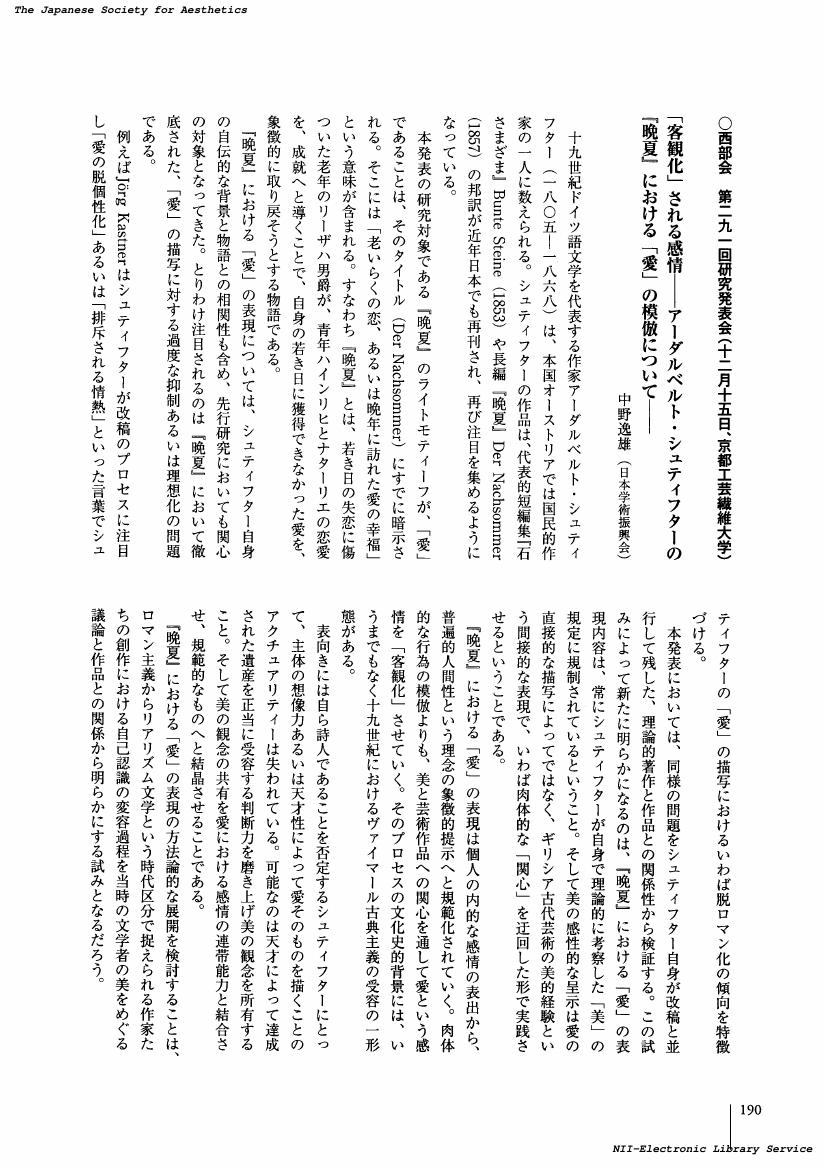- 著者
- 井岡 詩子
- 出版者
- 美学会
- 雑誌
- 美学 (ISSN:05200962)
- 巻号頁・発行日
- vol.64, no.2, pp.115, 2013-12-31 (Released:2017-05-22)
1 0 0 0 OA バウムガルテンの美学におけるフィグーラ論(第六十四回美学会全国大会発表要旨)
- 著者
- 井奥 陽子
- 出版者
- 美学会
- 雑誌
- 美学 (ISSN:05200962)
- 巻号頁・発行日
- vol.64, no.2, pp.116, 2013-12-31 (Released:2017-05-22)
1 0 0 0 OA 三島由紀夫 : 文体の美学(第六十四回美学会全国大会発表要旨)
- 著者
- 井上 聡
- 出版者
- 美学会
- 雑誌
- 美学 (ISSN:05200962)
- 巻号頁・発行日
- vol.64, no.2, pp.117, 2013-12-31 (Released:2017-05-22)
1 0 0 0 OA マルセル・デュシャンにおける「レディ・メイド」の生成(第六十四回美学会全国大会発表要旨)
- 著者
- 岩見 亮
- 出版者
- 美学会
- 雑誌
- 美学 (ISSN:05200962)
- 巻号頁・発行日
- vol.64, no.2, pp.118, 2013-12-31 (Released:2017-05-22)
1 0 0 0 OA 藝術としての哲学 : 「よりよい意識」からのショーペンハウアー哲学の誕生
- 著者
- 高橋 陽一郎
- 出版者
- 美学会
- 雑誌
- 美学 (ISSN:05200962)
- 巻号頁・発行日
- vol.64, no.2, pp.1-12, 2013-12-31 (Released:2017-05-22)
Fur Schopenhauer war die Philosophie nicht sowohl eine Wissenschaft als vielmehr eine Kunst. Aber von dem hat er in seinem Hauptwerk keines Deutliches erwahnt. Im Nachlass der fruheren Periode seines Denkens hat er aber vom Konzept der "Philosophie als Kunst" deutlich geredet. Demnach ist die Philosophie ein Ergebnis vom "bessren Bewusstseyn" als einem Vermogen, das die kiinstlerische Kontemplation und die moralische Tugend verwirklicht. Durch diese Anschauung uber die Philosophie wurde die Schopenhauersche Philosophie konzipiert. Den kunstlerischen Moment des Hauptwerkes kann man in seiner organischen Struktur finden, "wo das Ganze jeden Theil erhalt und (…) umgekehrt auch jeder Theil das Ganze und alle andern". Diese Struktur selbst ist eine Schonheit. Aber mehr hat die Struktur bei Schopenhauer die Bedeutung als Form, die uns die "Ideen der Welt" oder "einen einzigen Gedanken" anschauen lasst. Die Welt als Wille und Vorstellung (1818/19) wurde eben gemaig der Schopenhauers Anschauung uber die Philosophie vollendet. Die wahre Vollendung der "Philosophie als Kunst" besagte, keine Spuren des Konzepts derselben zu hinterlassen.
1 0 0 0 OA 三木清『構想力の論理』における構想力の造形力について
- 著者
- 清水 哲朗
- 出版者
- 美学会
- 雑誌
- 美学 (ISSN:05200962)
- 巻号頁・発行日
- vol.64, no.2, pp.13-24, 2013-12-31 (Released:2017-05-22)
Kiyoshi Miki (1897-1946) studied the aspect of imagination as for mythology, system, technology, and experience through The Logic of Imagination. In each theme, pathos and logos were involved each other. Among the involvement between pathos and logos various forms with imagination have been produced in history. Based on Miki's vision for imagination, in this paper I concider Miki's perspective for the themes concerning the power of imagination in Kant's critical philosophy. At each stage of the Kant's deduction in that case I will analyze how Kant found out the modeling power of imagination at the process of the deduction. For Kant's regulation of imagination I will think about how Miki considered the Kant's deployment of imagination compared with Mild's own logic of imagination. I will try to understand how Kant gave forms to imagination according to the each stage of his logic of imagination. Through such multi-layered examination for imagination as described above, I will be able to pursuit the significancies and possibilities of the modeling power of imagination.
1 0 0 0 OA 徂徠礼楽思想における学習論
- 著者
- 陳 貞竹
- 出版者
- 美学会
- 雑誌
- 美学 (ISSN:05200962)
- 巻号頁・発行日
- vol.64, no.2, pp.25-36, 2013-12-31 (Released:2017-05-22)
According to OgyuSorai's (荻生徂徠) theories, imitating and familiarizing oneself with the given models are the methods to study the Poetry, History, Rites and Music (詩書禮榮, ShiShuLiYue). As maintained in some earlier literature, Sorai shares some ideas with the studying methods of Japanese traditional arts, which are based on learning of models and manners. The conclusion, however, is not carefully reviewed. The studying theories of Sorai were developed through criticizing the theories of Zhu Xi (朱熹) and Ito Jinsai (伊藤仁齋). Sorai's criticism emphasizes that they consider the rites and music to be understood through language. From the perspective of Sorai, it is by practice that the rites and music are truly learned and comprehended. This article focuses on how Sorai criticized Zhu Xi and Jinsai and developed his own theories. Moreover, it makes comparisons between the studying methods of Sorai and Japanese traditional arts, and discusses Sorai's viewpoints on the existence of both human beings and nature to define the characteristics of Sorai's methods of studying.
1 0 0 0 OA 人文主義の範型としての詩的神学 : ルネサンス期の寓喩観とその歴史的特性
- 著者
- 田中 佳佑
- 出版者
- 美学会
- 雑誌
- 美学 (ISSN:05200962)
- 巻号頁・発行日
- vol.64, no.2, pp.37-48, 2013-12-31 (Released:2017-05-22)
There is a general theory of allegory accepted by many literary critics and philosophers; i.e. allegory is merely the figuration substitutes particular things for the universal concept. On the contrary, the aim in my paper is to produce counter evidences against this 'emblem' formula from the standpoint of theologia poetica which was the common topic among Italian Renaissance humanists. The advocates of it, such as Mussato, Petrarch, Salutati, and the Florentine Academicians thought the interpretation of allegory in poetry coincides with that in the Scripture, and poetry is also the medium of divine providence in accord with theology. Especially Salutati and Landino said poetry is the comprehensive science composed from all seven liberal arts, hence they presumed poetry to be the essence of the humanities and simultaneously the epistemological function of allegory to be to 'bring out something hidden in the fountain of divinity itself'. According to Landino, whether in the Scripture or in poetry, allegory 'embellishes' the truth with 'marvellous pleasure', and through the maze' of allegory one can reach the summit of knowledge'. In the view of such humanists, allegory is not figuration but the act of knowing, and consequently theologia poetica was the ideal of humanism.
- 著者
- 並木 誠士
- 出版者
- 美学会
- 雑誌
- 美学 (ISSN:05200962)
- 巻号頁・発行日
- vol.64, no.1, pp.191, 2013-06-30 (Released:2017-05-22)
- 著者
- 辻 麻衣子
- 出版者
- 美学会
- 雑誌
- 美学 (ISSN:05200962)
- 巻号頁・発行日
- vol.64, no.1, pp.192, 2013-06-30 (Released:2017-05-22)
- 著者
- 村山 康男
- 出版者
- 美学会
- 雑誌
- 美学 (ISSN:05200962)
- 巻号頁・発行日
- vol.64, no.1, pp.193, 2013-06-30 (Released:2017-05-22)
- 著者
- 土田 耕督
- 出版者
- 美学会
- 雑誌
- 美学 (ISSN:05200962)
- 巻号頁・発行日
- vol.64, no.1, pp.196, 2013-06-30 (Released:2017-05-22)
1 0 0 0 OA 「縫う女性」の表象 : 『ゴーディズ・レディズ・ブック』を手がかりに
- 著者
- 平芳 裕子
- 出版者
- 美学会
- 雑誌
- 美学 (ISSN:05200962)
- 巻号頁・発行日
- vol.64, no.1, pp.155-166, 2013-06-30 (Released:2017-05-22)
Godey's Lady's Book was the most popular women's magazine in 19^<th>-century America. Although the magazine enjoyed great popularity due to articles on fashion and manners of the upper social class, the impoverished seamstress and sewing housewives had suddenly described from the late 1840s. In this paper, I examine the characteristics and meanings of the representation of sewing women between the late 1840s and early 1850s in the magazine. Since launching, the magazine had printed the articles on embroidery as ladies' accomplishment, not needlework. However, with the expansion of national land and development of cities, the increase of subscriber, popularization of journalism, it is provided greater value to the sewing for domestic works and side jobs as "women's work." The single-mindedly sewing women came to function as the new symbol of femininity instead of the spinning and weaving women who had disappeared as a result of the development of textile manufacturing. The sewing women, which had been depicted for a little more than five years and disappeared along with the dissemination of paper patterns and sewing machines, visualizes not only the fluctuation of the division of housework and labor in American society, but also how the women became sutured into their home.
- 著者
- 川野 惠子
- 出版者
- 美学会
- 雑誌
- 美学 (ISSN:05200962)
- 巻号頁・発行日
- vol.64, no.1, pp.167-178, 2013-06-30 (Released:2017-05-22)
Ce texte analyse le concept d' <<action>> darts Lettres sur la danse, et sur les ballets (1760) de J.-G. Noverre. Le terme <<action>> apparait 119 fois dans ces Lettres et est employe a double sens. Premierement, on entend par ce terme l'expression corporelle provoquee par la passion interieure. A cette epoque-la, la danse suivait en general une intrigue. Mais beaucoup d'oeuvres confiaient le deroulement de l'intrigue aux dialogues du prologue ou a des costumes allegoriques, et limitaient la danse aux simples mouvements. De telles oeuvres ont ete critiquees par Noverre. Il affirme que les mouvements de la danse sont constructs a partir de la passion du danseur qui est habite par le role qu'il doit interpreter. Tous ses gestes et mouvements ne sont que l'action decrite par Noverre. Le deuxieme sens du terme <<action>> concerne la composition de la scene. Cate action se rapporte a l'unite d'action d'Aristote. Mais l'important est que cette action soit associee au terme <<interet>>. Noverre affirme que l'espace de la scene doit construire une illusion par la perspective et la gradation de couleur. Grace a l'illusion, la composition de la scene attire l'interet du public. Si ces deux actions s'accomplissent sur scene, le livret qui est rebarbatif a la lecture devient vif et toujours renouvele.
- 著者
- 渡辺 裕
- 出版者
- 美学会
- 雑誌
- 美学 (ISSN:05200962)
- 巻号頁・発行日
- vol.64, no.1, pp.179-182, 2013-06-30 (Released:2017-05-22)
- 著者
- 田中 佳佑
- 出版者
- 美学会
- 雑誌
- 美学 (ISSN:05200962)
- 巻号頁・発行日
- vol.64, no.1, pp.188, 2013-06-30 (Released:2017-05-22)
- 著者
- 伊東 多佳子
- 出版者
- 美学会
- 雑誌
- 美学 (ISSN:05200962)
- 巻号頁・発行日
- vol.64, no.1, pp.189, 2013-06-30 (Released:2017-05-22)
- 著者
- 中野 逸雄
- 出版者
- 美学会
- 雑誌
- 美学 (ISSN:05200962)
- 巻号頁・発行日
- vol.64, no.1, pp.190, 2013-06-30 (Released:2017-05-22)
- 著者
- 奥村 京子
- 出版者
- 美学会
- 雑誌
- 美学 (ISSN:05200962)
- 巻号頁・発行日
- vol.64, no.1, pp.83-94, 2013-06-30 (Released:2017-05-22)
During the period 1988-1993, Gyorgy Ligeti (1923-2006) composed the Nonsense Madrigals, which included six tunes for six male voices. For the text of the final tune, "A Long, Sad Tale," Ligeti borrowed from Lewis Carroll's Alice in Wonderland (1865) and his word game doublets. This paper discusses the musical structure of "A Long, Sad Tale." In the tune, Ligeti combined pulsative word-patterns of four doublets, the howling voice of the Queen of Hearts, a conversational sentence between Alice and the mouse, and a trial tale of a violent dog against the whining mouse. He highlighted the personalities of the characters, and set the text in multiple voices to create an emotional polyphony. Moreover, he created not only an elastic metrical structure in a manner through which all kinds of time signatures frequently change but also a jigsaw puzzle-like structure that was based on multiples of sixteen.
- 著者
- 二宮 洋輔
- 出版者
- 美学会
- 雑誌
- 美学 (ISSN:05200962)
- 巻号頁・発行日
- vol.64, no.1, pp.107-118, 2013-06-30 (Released:2017-05-22)
This paper attempts to reveal the relevance between the composition of Pembroke Family Portrait (which has been emphasized on the influence of the Venetian paintings, especially the history paintings of Titian) and its subject of marriage in the context of the court masques. Beholder's eyes are led from cupids to Charles and Mary, and then, to the huge coat of Arms of the Earl of Pembroke. This is a visualization of prosperity of the family through their marriage, and it corresponds to the typical subjects of masques: prosperity of Britain through the love of King and Queen. Therefore, this work can be seen as the response of the Pembroke (he was "Lord Chamberlain" who takes charge of playing the court masques) to the norms which masques advocated as "the mirrors of man's life". In addition, the temple-like building in this work resembles the stage design of masques which frequently used in the scene of "order" gained through the overcoming of "chaos". This synopsis tallies with the circumstances of this marriage: its main purpose was to resolve the confrontation between William, 3^<rd> Earl of Pembroke and the Duke of Buckingham. From the above, this work recalls not only the Venetian paintings, but narrative or stage effects of the court masques.











